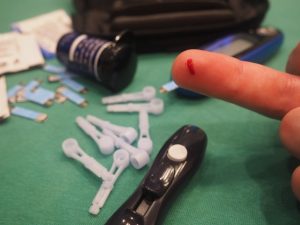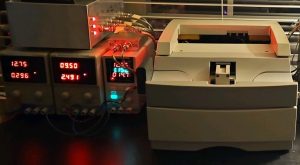Our Mission Is To
Bring health and better quality to life to everyone.
What Artemis Biomedical does:
We seek to provide diabetics and medical patients of all kinds a method to reliably and repeatably test blood sugar without using needles, probes, or implants. We believe that taking care of your health should not be painful or burdensome. Our patented technology is painless and dependable.
Who We Are
The Artemis team has been involved in non-invasive glucose measurement technology since the 1990s. We are comprised of scientists and engineers dedicated to bringing relief to the suffering diabetic. For decades we have researched and developed measurement technology and have special expertise with optics. We each have been affected by diabetes and have personal incentive to making this technology available and reliable.
Why measure glucose in the blood?
For diabetics, measuring blood glucose can be a matter of life or death. Frequently checking blood sugar allows the diabetic to have better control over their bodies.
What is diabetes?
There is an epidemic of diabetes in the US, and throughout the world. An estimated 1 in 3, (nearing 1 in 2) people are diabetic or prediabetic. So what is it?
In short, diabetes is the inability for the body to adequately regulate glucose in the blood (often called blood sugar). The pancreas is an organ in the body that regulates a hormone called insulin. Diabetes is the result of the pancreas not functioning properly and producing the proper quantity of insulin. Insulin lowers how much glucose is in the blood.
Type I diabetes is the most severe form of diabetes. In the type I diabetic, the pancreas is unable to produce almost any of its own insulin. It is not considered a preventable disease, but is believed to be due to genetics or environmental conditions causing an autoimmune response that damages the pancreas. Usually, injections of insulin are required daily to maintain a lower blood sugar. Any time a person–diabetic or not–eats or consumes beverages with carbohydrates or sugars, that person’s level of glucose in the blood will increase. Without insulin, glucose can heavily saturate the blood to dangerous levels.
Type II diabetes is the most common form of diabetes. It usually develops in adulthood. In type II diabetics, the pancreas doesn’t produce enough insulin, but sometimes, depending on the severity of diabetes in the individual, by avoiding sugars, the disease can be managed without regular injections of insulin. It is thought that lifestyle choices may be able to prevent type II diabetes, but doing so often requires dedication and great effort, and can sometimes be cost-prohibitive in some areas and cultures. Many people are not even aware of diabetes or the risk of developing diabetes as a result of diet and lifestyle.
Prediabetes is a term to describe when a person regularly has high blood sugar, but not high enough to be clinically diagnosed as diabetes. It is still due to the body not producing insulin at healthy levels.
Hyperglycemia is the term used to describe a high blood sugar. This is usually only present when the pancreas isn’t working properly such as in diabetes. Blood sugar will always go up after eating or drinking, but it isn’t usually considered high until measured at above 140mg/dL 2 hours after eating.
Hypoglycemia is the term used to describe low blood sugar. This may be caused by improper functioning of other organs such as the liver. Hypoglycemia is not limited to diabetics and many suffer from the condition. Everyone gets low blood sugar from time to time, usually after not eating for a few hours. However, there is a normal range of blood sugar that varies depending on when you last ate or drank, usually it is considered hypoglycemia when it drops below 70mg/dL.

Images from the 2019 edition of the International Diabetes Federation “Diabetes Atlas”.
Why test?

Both hyperglycemia and hypoglycemia are dangerous, whether at extreme levels or when chronic.
Short term effects of severe hyperglycemia can be increased thirst and urination due to the kidneys trying to flush the excess glucose, fatigue, nausea and vomiting, abdominal pain, blurred vision, confusion, fever, and when high enough, coma. Chronic hyperglycemia can cause cardiovascular disease, nerve damage-including nerve damage to the retina that causes blindness (diabetes is the 5th leading cause of blindness worldwide), kidney damage, kidney disease, joint and bone problems, teeth and gum infections, increased risk for infections (diabetic infections are the #1 cause for amputations in the US), and brain damage.
Short term effects of severe hypoglycemia can be confusion, difficulty concentrating, cold sweats, tremors (shakiness), anxiety, extreme fatigue, racing pulse, brain bleeding, heart attack, and nausea and vomiting. Chronic low blood sugar can cause weight loss due to lack of appetite, increased risk of nerve damage, neuropathy, kidney disease, heart disease, and eye disease.
By monitoring blood sugar regularly, a person at risk for hyperglycemia or hypoglycemia can prevent all of these symptoms and complications by self-administering carbohydrates when blood sugar is getting low and avoiding over-consumption and administering insulin and other medications when it is getting high.
There's a problem with testing.
Right now there are very few methods approved for reliable use by the FDA or similar agencies for measuring blood glucose. They require a sample of bodily fluids, usually blood. Glucose can be measured in many other bodily fluids, but typically the amount of glucose in the blood itself is what can damage organs and is usually the fastest form of transportation for glucose in the body. Glucose tests typically work by a sample of enzymes that react to the glucose in the blood, which can be measured with an electrical signal.
The most common method of measuring blood glucose is with a handheld device often referred to as a glucometer. Typically the patient will take a lancelet (small needle, usually spring loaded to be quick and less painful), draw a drop of blood from the pierced skin, place some of the blood on a testing strip containing enzymes and the electrical components to read the reaction, which is inserted into the glucometer to be read. This is a very reliable method and easy for diabetics to take with them, but it has some significant drawbacks. For one it is painful. Our bodies make us avoid pain and avoid losing blood, even small amounts. We have a natural aversion to giving ourselves even the smallest wound. This is especially difficult for type I diabetics who are often children, sometimes even infants when they begin needing to monitor blood sugar. It can also be difficult for parents of type I diabetics to regularly prick their children. Several studies done on frequency of testing have reported the number one reason diabetics don’t test their blood sugar as frequently as is recommended (as many as 5 or more times a day, depending on the source of the recommendation) is that it is painful.
The other method that is gaining popularity, especially with the advent of smart phones, is the Continuous Glucose Monitoring (CGM) device. The CGM devices that are currently approved for use will either measure the glucose in blood or interstitial fluid (fluid between cells in the skin). Sometimes a probe is implanted under the skin or with applied to the surface of the skin with an adhesive backed patch. There is a probe component and an interface, many of the models are meant to connect to a cell phone. The probe constantly takes measurements and sends the data to the interface which logs, creates trends, sometimes they worn the user of high or low readings.
These are often more helpful to diabetics to monitor their bodies and learn more about how their habits effect their blood sugar.

However, they have several draw backs. The probes must be replaced after a certain period of time. Many of the probes still have a needle or needle like probe that can be uncomfortable to where. A large percentage of users have reactions to the adhesives used on the patches.The probes inserted under the skin are reported as uncomfortable, especially during implant. Some insurances don’t cover these devices, or cover very minimally, and they are often too expensive for most people, especially since the cost of diabetic supplies, particularly insulin, is incredibly high.
So if testing is so important to healthy living as a diabetic, why do people neglect testing? In summary, it hurts. No one likes to prick themselves with a needle. Having an implant is not comfortable. None of the methods to test glucose right now, especially those that are FDA approved as reliable, are pain or discomfort free. They also tend to be expensive for the majority of people.
The Artemis Solution:
 Controlling glucose within a tight range is the cornerstone of your comprehensive program to maintain good health all through life. Control begins with knowing your numbers and frequent testing is central to having the information you need. Our goal is to bring you a TRULY pain free, safe, and reliable method of testing blood sugar to help keep track of your health. The team at Artemis Biomedical Technologies Inc. Have your health in mind. Each member of our team has been impacted by diabetes. Our parents, our siblings, our children, and some of our own team members struggle with blood sugar disorders. Each of us know first hand what happens when we don’t test. Each of us knows how painful and uncomfortable testing is right now. We want to bring this technology to everyone. Our members became involved in light-based glucometry more than 20 years ago and have continued to improve upon previous achievements.
Controlling glucose within a tight range is the cornerstone of your comprehensive program to maintain good health all through life. Control begins with knowing your numbers and frequent testing is central to having the information you need. Our goal is to bring you a TRULY pain free, safe, and reliable method of testing blood sugar to help keep track of your health. The team at Artemis Biomedical Technologies Inc. Have your health in mind. Each member of our team has been impacted by diabetes. Our parents, our siblings, our children, and some of our own team members struggle with blood sugar disorders. Each of us know first hand what happens when we don’t test. Each of us knows how painful and uncomfortable testing is right now. We want to bring this technology to everyone. Our members became involved in light-based glucometry more than 20 years ago and have continued to improve upon previous achievements.
Meet the Team
Jeremy Grata, Founder, CEO
Jeremy has a background in physics, the natural sciences and mathematics. He has three decades of experience in product development, specializing in optical technology. He oversaw projects from concept to production and spent a significant portion of his career leading teams to create solutions to automate the manufacturing process. Jeremy has led multimillion dollar projects and has held leadership positions for many years including VP of Engineering.
Mike Pitsakis, Founder, CTO
Mike has a background in electrical engineering and has spent more than 3 decades working to develop highly sophisticated devices. Much of his career has been in designing and implementing digital and analog electronic systems, especially opto-electronic . He has decades of experience in establishing environments for technological development compliant to ISO and FDA/GMP regulations and has implemented compliant policies for standardizing multiple companies.
Both Jeremy and Mike began working on the original project that turned into the core technology of the Artemis glucometer in the 90s, and they have continued to develop and advance the technology in the decades since they began. They have filed patents, published papers and developed solutions to the limitations of the original technology. They have worked together for many years leading projects developing complex optical technology and created advanced teams adhering to the highest standard of quality. Besides the Artemis glucometer technology, they have developed multiple products and established sophisticated automated manufacturing lines.
Jeremy and Mike have decades of work and hundreds of long days, nights and weekends invested into this technology. They strive to bring this product to its fullest potential. Besides the time and effort already invested, they also have additional personal motivation in this project as they both have close family members and friends that suffer with diabetes and blood sugar disorders. They want this technology to be available for all who suffer from such diseases so that they may have a pain-free alternative that helps them to live healthier lives.

